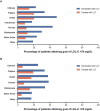Prevalence of plasma lipid disorders with an emphasis on LDL cholesterol in selected countries in the Asia-Pacific region
- PMID: 33858442
- PMCID: PMC8051043
- DOI: 10.1186/s12944-021-01450-8
Prevalence of plasma lipid disorders with an emphasis on LDL cholesterol in selected countries in the Asia-Pacific region
Abstract
Cardiovascular disease (CVD) is a major cause of mortality and morbidity within the Asia-Pacific region, with the prevalence of CVD risk factors such as plasma lipid disorders increasing in many Asian countries. As members of the Cardiovascular RISk Prevention (CRISP) in Asia network, the authors have focused on plasma lipid disorders in the six countries within which they have clinical experience: Indonesia, Malaysia, Philippines, Thailand, Vietnam, and Australia. Based on country-specific national surveys, the prevalence of abnormal levels of total cholesterol, low- and high-density lipoprotein cholesterol (LDL-C and HDL-C, respectively), and triglycerides (TG) are reported. An important caveat is that countries have used different thresholds to define plasma lipid disorders, making direct comparisons difficult. The prevalence of abnormal lipid levels was as follows: high total cholesterol (30.2-47.7%, thresholds: 190-213 mg/dL); high LDL-C (33.2-47.5%; thresholds: 130-135 mg/dL); low/abnormal HDL-C (22.9-72.0%; thresholds: 39-50 mg/dL); and high/abnormal TG (13.9-38.7%; thresholds: 150-177 mg/dL). Similarities and differences between country-specific guidelines for the management of plasma lipid disorders are highlighted. Based on the authors' clinical experience, some of the possible reasons for suboptimal management of plasma lipid disorders in each country are described. Issues common to several countries include physician reluctance to prescribe high-dose and/or high-intensity statins and poor understanding of disease, treatments, and side effects among patients. Treatment costs and geographical constraints have also hampered disease management in Indonesia and the Philippines. Understanding the factors governing the prevalence of plasma lipid disorders helps enhance strategies to reduce the burden of CVD in the Asia-Pacific region.
Keywords: Asia-Pacific; Dyslipidemia; Guidelines; Plasma lipid disorders; Prevalence.
Conflict of interest statement
Zhen-Vin Lee has received honoraria from Aspen, AstraZeneca, Bayer, Boehringer Ingelheim, Merck, Merck Sharp & Dohme, Novartis, Pfizer Upjohn, and Servier. Renan Sukmawan has received speaker’s fees and honoraria for ad boards from AstraZeneca, Merck Sharp & Dohme, Mitsubishi Tanabe Pharma, and Pfizer Upjohn. Nuntakorn Thongtang has received research funding from Pfizer Upjohn. Ho Huynh Quang Tri has received speaker’s fees from Pfizer Upjohn, AstraZeneca, and Merck Sharp & Dohme. Philip Barter has received honoraria for consultancies and ad boards from Pfizer Upjohn and Amgen. Elmer Llanes has received speaker’s fees from AstraZeneca, Orient EuroPharma, Merck Sharp & Dohme, and LRI-Therapharma.
Figures




References
-
- Ritchie H, Roser M. Causes of death. 2019.
Publication types
MeSH terms
Substances
LinkOut - more resources
Full Text Sources
Other Literature Sources
Medical
Research Materials
Miscellaneous

